Audi RS2 Avant (1994 – 1995) Review
Audi RS2 Avant (1994 – 1995) At A Glance



The Audi RS2 Avant was produced in a fascinating - and very exciting - joint venture with Porsche. It was based on the 80 Avant S2, and was powered by a modified version of its 2.2-litre five-cylinder 20-valve turbocharged engine that developed 311bhp. Final assembly was completed by Porsche in Zuffenhausen. Performance was predictably brisk, with especially vivid acceleration - Autocar magazine famously timed the RS2 from 0-30mph in 1.5 seconds, which was quicker than a McLaren F1.
Such facts are what legends are based on, and Audi was clever enough to capitalise on the RS2's critical success, by following it up with generations of super-estate cars, making the genre its own, despite strong competition from Mercedes-Benz in particular. The Audi's handling was excellent, thanks to the Porsche-designed braking and suspension systems - the Porsche Cup brakes being carried over straight from the 964. Styling was low-key, but there were enough changes for the RS2 to be recognisable to cogniscenti - it's a classic now, and was the moment it left the production line.
Model History
March 1994
Audi RS2 goes into production
The RS2 Avant is built by Porsche at its Rossle-Bau plant in Zuffenhausen, Germany.
July 1995
Production ends
Audi RS2 Avant production ends after 2891 cars are built
Driving Audi RS2 Avant (1994 – 1995)
The Audi RS2 Avant was launched mere months before the production's end of the 80, the car it was based on. But the RS2 was something very special indeed - as much a case of saving the best 'til last, as the beginning of a new chapter in its maker's history.
Built at Porsche's factory in Zuffenhausen, the RS2 combined super-sports car acceleration with five-door practicality, to create the era's ultimate performance car for the family. Since the RS2, Audi has had at least one ballistic estate car in its line-up, and has pretty much cornered the market. We run it around the Isle of Man TT Circuit to see of its legendary status is deserved.
Classic road test: Audi RS2 Avant
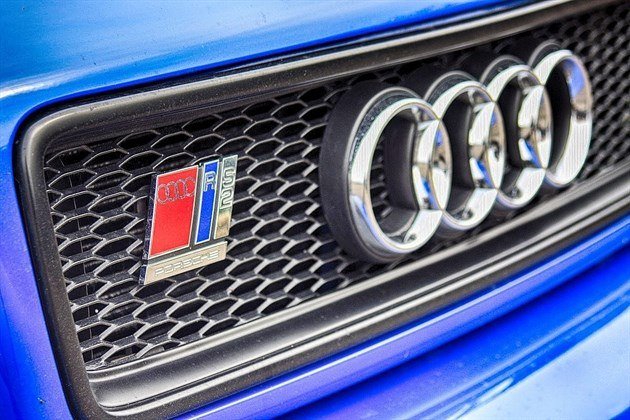
The Audi Sport badge - but look closely, and you'll see it's combined with Porsche.
You know how some cars can become legends in their own lifetime, on the back of something amazing that they achieved, or because of some influential technical innovation? Or perhaps they had an important place in cultural history? The Audi RS2 Avant's legendary status was acquired rather differently. The moment that Autocar magazine strapped its timing gear to the original test car back in 1994, and scorched from 0-30mph in 1.5 seconds, the immortal headline wrote itself: 'Faster than the McLaren F1’.
And that was it - this perfect Q-car from Audi and Porsche had made it to the automotive hall of fame. Twenty years on from the launch of the first Audi RS model, people still talk about that accelerative feat meted out by the road testers, in much the same way they'll whisper reverently about the 176mph maximum speed of the Vauxhall Lotus Carlton. But just because the Audi was otherworldly quick, should it be lined-up alongside the motoring greats?
To celebrate the 20th anniversary of its launch in 1994, we took Audi Heritage's very own factory-fresh RS2 for a fast dash to the Isle of Man TT circuit, to sample this supercar-baiting estate car on the only derestricted public roads in the British Isles - the perfect playground for a four-wheel drive turbocharged super-estate capable of more than 160mph. We weren't going to to push it that hard - not with the changeable February weather in the mountains, and the fact you're still mixing it with daytime traffic.
But mostly, this timewarp condition car had fewer than 1000 miles on the clock, making this one pretty much priceless. A big thanks, then, to Audi for entrusting it with us.
About the Audi RS2 Avant
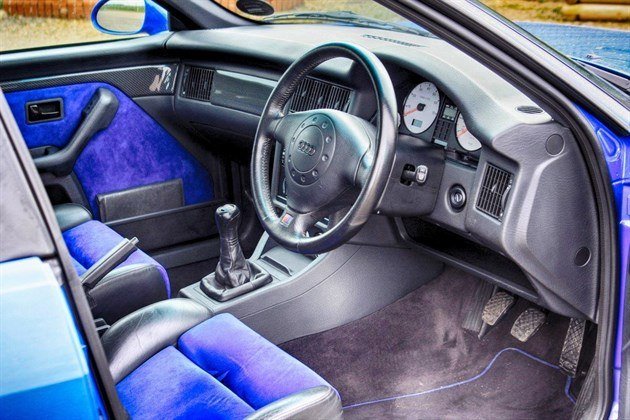
Workmanlike and supremely well-made interior is brightened by the addition of electric blue Alcantara
So we've already established that Audi's reputation for building monster estate cars began with the RS2. But Audi made sure that when it kicked off its RS brand, it did so in some style - so the RS2 was built in a joint venture between Audi and Porsche on the Stuttgart company's production line in Zuffenhausen. In 1994, this blend of estate car practicality and 315bhp was utterly unique, and it was certainly eye-catching.
Given that the 80 it was loosely based upon was also available in saloon and coupe form, it was a surprise to the the company's first RS model emerged as an estate. The more obvious answer might have been to build it out of the three-door coupe, to create a true replacement for the UR-quattro - but in retrospect, taking the route it did was a marketing masterstroke.
The RS2 was based on the existing Audi S2 - itself touted as the UR-quattro's replacement when it went on sale in 1990. And in essence the RS2 was a tuned version of it. The RS2 was powered by a heavily revised version of Audi’s brillliant 2.2-litre 20-valve five-cylinder engine, which in the base car, developed 230bhp. Porsche then installed a much larger KKK24 turbocharger, with significantly more boost, added a heavy-duty intercooler, improved its induction system and exhaust, added a redesigned camshaft and a new engine management system. Power was up to 315bhp, and torque boosted to 302lb ft. That was enough to put clear water between this, and established fast saloons such as the BMW M3.
Audi, then, stood alone in its market sector. But the RS2 was thoroughly developed away from the engine, too. The suspension an damping was improved to handle the additional power, and its Porsche Cup alloys were shod with bespoke tyres. Reining it all in were Porsche brakes - a very visible upgade. Porsche door mirrors, front fog lights, projector headlamps, and a new full-width reflector panel were all unique to the RS2. Inside, it received Recaro seats (with their tilting mechanism for two-door cars still in place!), new instruments, and uprated Alcantara trim. In short, the differences were legion. but you'd need to be an aficionado to spot them.
But you paid for the privalege. The list price at launch in the UK in late 1994 was a cool £45,705. To put that into perspective, a new 286bhp E36-generation BMW M3 cost £33,850, a Jaguar XJR cost £45,450 and a Mercedes-Benz C36 AMG would have set you back £38,250. Of course, the Audi could blow all of these challengers into the weeds effortlessly - but a marker had been laid. The RS2's launch marked the beginning of super-saloon/estate/coupe arms race, which still rages to this day.
On the road
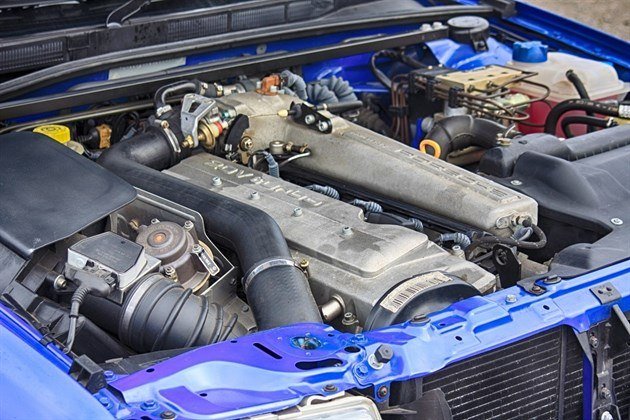
The RS2 Avant's turbocharged 20-valve five-cylinder engine is lifted by the addition of Porsche branding on the inlet manifold. And it's not just there for show.
For a car that rewrote the rules in 1994, the Audi RS2 is reassuringly low-key to look at. Yes, it's obvious that this is no ordinary 80 Avant, given the 17-inch wheels, bodykit and subtle Porsche modifications, but when you first set eyes on the RS2, it commands respect, because of its near-complete lack of marketing-led addenda. If anything's non-standard, it's there for a reason, and we love it for that.
Jumping inside, and the high quality 80 interior manages - just - to carry off that eye-watering price tag. It's tightly screwed together, and looks well-integrated in an industrial kind of way. The material quality, though, it exceptional for a car of this era, and clearly is was put together while the accountants were looking the other way. The big, silver faced dials are easy on the eyes (and you have to love a car with a 180mph speedo), while the trio of auxillary dials, nesling low in the centre console may perform and important role - but most drivers won't ever look at them, so far out of the line of sight hey are.
The driving position is okay, with a cramped pedal box and non-adjustable steering wheel proving nigglesome. The Recaro seats are brilliant - supportive and great looking - and once you find the tiny electrical adjusters, you'll soon find playing with them will get most drivers comfortable. Equipment levels are good by the standards of the day (we miss remote central locking, and that's about it), and most drivers won't feel like they're lacking anything - even if jumping in from a new car.
Time to get moving. We had a 200-mile drive up to Heysham, where the Isle of Man ferry sails from, which is plenty of time to get to know the RS2 Avant. The controls are straightforward, visibility is excellent, and thanks to height adjustment, you can hunker down into the car on its lowest position, or rise it up for a more conventional driving position - perfect for the 3000rpm sixth-gear cruise. As the miles roll by, it's hard not to be impressed by the docility of the engine in real-world driving conditions. And the ride, too - it's not bony or stiff inthe way later RSs are, and the damping is superb.
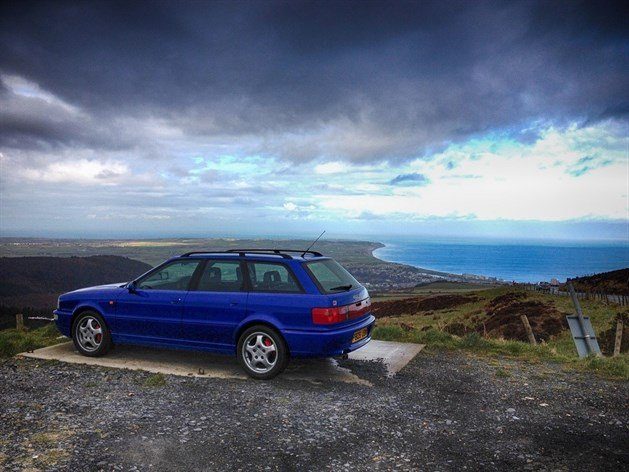
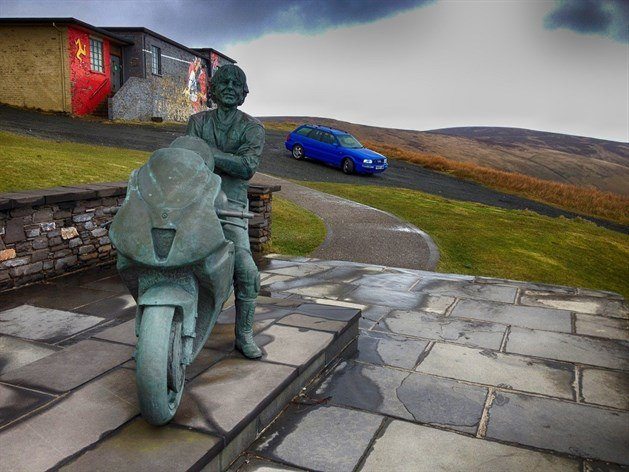
Motorways are great for familiarisation, but the TT Circuit awaits, and we're keen to see if the RS2 is as good a driver's car as we're hoping. Off the ferry, and the lure of the ciircuit is irresistible. On the run through Douglas and towards the start/finish line, and that docile impression earned on the motorway is maintained. The steering is light for a performance car, and the gearchange is smooth and chunky.
Finding the circuit is straightforward - just follow the signs - and then it's a case of following the black and white kerbing on the roadside and the signs for Ramsey. How the bikers reach the speeds they do on these narrow, cambered roads, with so many immovable roadside objects, beggar's belief. At the first derestricted road sign, we open up the RS2, and love the way that the five-cylinder engine thrums away, in a creamy way that become more hard-endged and urgent once 4500rpm is passed. Then, all hell breaks loose, as the full 315bhp reached for the 7000rpm rev limter. That is where the RS2 wakes up, grabs our attention, and stops being merely a fast car - it's up here that it's also inspirational.
We pass slowly through a series of villages, before running through Ramsey's Parliament Square. From here on in, it's derestricted mountain roads, a combination of steep climbs, hairpin bends, and high speed sweeping bends. Dream material, especially given the lack of any speed limits, and light traffic. We're prepared to deal with the turbo lag, which can leave you floundering when you need instant power.
Even before exit of the first hairpin, we floor the throttle to overcome turbo lag. It's here that the RS2's other talent seduces us. Get the timing right, and the turbo hammers in right at the apex, and slighshots, with huge reserves of grip and lateral G-loadings and out on a wave of unrelenting power. Thanks to the five-cylinder's smoothness, leaving it in a lower gear than you might be expected to, is the way to go - keep it between 4500 and 7000rpm, regardless of the gear will see you rocket down the straights devastatingly quickly. The other thing is that once you're cracking on, that slightly aloof steering wakes up and starts talking to you.
The quattro all-wheel drive system performs magic tricks, too. The Isle of Man has its own micro-climate, and it seems like the weather changes at each turn of the road. We're treated to sun, rain and lashing wind, and at no point does the RS2 feel fazed by what the weather's throwing at us. On damp, greasy roads, it feels bolted to the road - and although you feel the torque transfer when really pushing, it's beningn and predictable.
The brakes are interesting. They initially feel wooden, and you'll need to push harder than you would in a modern equivalent, but the retardation they offer is fantastic. And on the Isle of Man's demanding TT Circuit, not once do they show signs of fading, even after some pretty big stops. That'll be the Porsche influence, then.
After hours of playing in the mountains, retracing our steps, time and time again, we really fall for the RS2. Its combination of grip, traction, and on-boost acceleration are near-narcotic on the island. It proved itself on these demanding roads, and came alive wben really pushed, just like a proper performance should. But that's what the RS2 is - a throroughbred performance car that just happens to be estate shaped.
The HJClassics Verdict
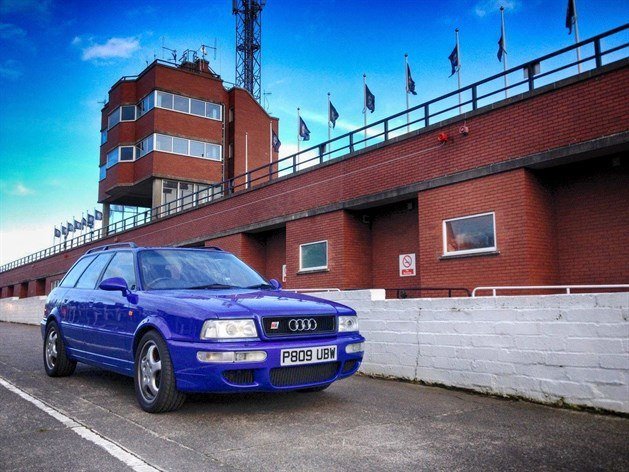
Audi RS2 at rest in the pits at Douglas
Coming up with a rational verdict for the Audi RS2 is not easy following such an exhillarating driving experience is never going to be straightforward. The buzz of a drive of this calibre is always going to leave any enthusiast feeling inspired, and reaching for superlatives. But in the case of the RS2, this is probably jusified given this car's ability to thrill and impress once it's in the turbo-zone.
Its classic credentials are cast iron - it was built by Porsche in small numbers, and as far as the UK is concerns, it's available in penny numbers at strong prices. If you can afford an RS2, and have room in your life for a classic superestate, there's no real alternatve that serves up the same level of performance, dynamics and all-weather safety.
In the annals of Audi history, it might not have as many fans as the UR quattro, but arguably, the RS2 has had a greater bearing on the development of its maker's performance cars over the years. Would we recommend one? Almost without reservations - only one aspect of ownership bothers us, and that's the paucity of parts, should anything break. The Porsche parts, ironically, are now the easiest to source. Otherwise, it's a cast-iron five-star car - a true legend that deserves all the praise it receives - and one we'd recommend to a classic driving enthusiast in a heartbeat.

The RS2 Avant is perhaps one of the most discreet performance cars of its kind - despite screaming Nogaro Blue paintwork and Porsche-branded red brake calipers.
Audi RS2 Avant (1994 – 1995) Buying Guide
Good
- The 2.2-litre five-cylinder is one of the most rugged engines Audi ever made.
- High mileages are not a problem for these power units.
- The for-wheel drive transmission is also, supremely tough.
- General servicing is actually reasonably priced.
- Some Porsche parts can be sourced cheaply.
Bad
- Gearbox itself is weak, and is known to break first gear on hard-used examples
- The original Dunlop tyres are almost impossible to find
- Finding parts - a usual Audi bugbear - is getting diffcult, especially for RS2-specific items
Watch
- The cambelt repacement interval is 80,000 miles - make sure it’s been done
- Make sure there are no untoward noises from the gearbox - if so, it's likely to be a first gear or selector, both expensive to sort.
- Spark plugs can rattle loose - check them regularly, and replace every 20,000 miles.
- Coil packs are also known to fail, so check for any signs of rough runnning. It's a £400-plus job to sort.
- Check the handbrake, as the cable is known to stretch and lose efficiency.
- The auxiliary water pump that comes on after the car has been running need to be checked regularly - they cool the turbo and therefore, it needs to be working. It's a relatively simple fix.
- Brake pad runner plates can lift due to corrosion where aluminium and stainless steel meet.

.JPG?width=640&height=426&rmode=crop)
.JPG?width=640&height=426&rmode=crop)
.JPG?width=640&height=426&rmode=crop)
.JPG?width=640&height=426&rmode=crop)
.JPG?width=640&height=426&rmode=crop)
.JPG?width=640&height=426&rmode=crop)
.jpg?width=640&height=426&rmode=crop)
.jpg?width=640&height=426&rmode=crop)
.JPG?width=640&height=426&rmode=crop)
.JPG?width=640&height=426&rmode=crop)